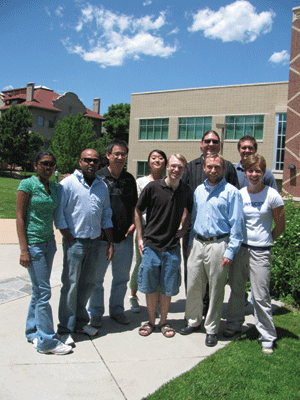White House Recognition for Alumnus-Professor’s Work on Fuel Cells
 President Barack Obama has named Ryan O’Hayre ’99 a recipient of a Presidential Early Career Award for Scientists and Engineers, the highest honor bestowed by the United States government on young professionals in the early stages of their independent research careers.
President Barack Obama has named Ryan O’Hayre ’99 a recipient of a Presidential Early Career Award for Scientists and Engineers, the highest honor bestowed by the United States government on young professionals in the early stages of their independent research careers.
“These extraordinarily gifted young scientists and engineers represent the best in our country,” remarked Obama of the 100 scientists and engineers.
O’Hayre, an assistant professor in the Metallurgical and Materials Engineering Department at Mines, will receive the award at a White House ceremony scheduled for January 13.
The award is accompanied by a grant that will go toward advancing fuel cell research, a field in which O’Hayre has quickly established an impressive record; just five years out from earning his PhD from Stanford, he’s invented a technology for measuring electrochemical phenomena at the nanoscale, helped achieve a scientific breakthrough that brings the economic feasibility of fuel cells significantly closer, and written the lion’s share of Fuel Cell Fundamentals, now the leading college textbook on the subject.
The PECASE also recognizes O’Hayre’s commitment to education in general and Colorado School of Mines in particular. “I always wanted to come back to Mines and inspire undergrads in the same way I was inspired here,” says O’Hayre. “I have a special place in my heart for the school.” And having been a Boettcher Scholar, he speaks of a desire to give back to the state.
O’Hayre is quick to share credit for the award. “This is a tremendous honor, but it never could have been achieved without the fantastic support I’ve received from Mines, the Metallurgical and Materials Engineering Department, the Army Research Office, and especially my colleagues at the Colorado Center for Advanced Ceramics, the Colorado Fuel Cell Center, and the National Renewable Energy Laboratory,” says O’Hayre, adding that having access to one of the best fuel cell research laboratories in the world and the nation’s top renewable energy laboratory helped him hit the ground running at Mines. He also highlights the contributions of his graduate students. “Without them, this award wouldn’t have happened. It’s their hard work that’s generating the results. They deserve a lot more of the credit than I do,” he says.
David Ginley, a research fellow and group manager at NREL, has been a mentor to O’Hayre for the past decade. They met when O’Hayre asked him to be his graduate advisor. “I offered him a position, and then told him he shouldn’t take it,” says Ginley, who instead advised O’Hayre to go study somewhere completely different. The two remained in contact, and since O’Hayre’s return, they have collaborated closely. What’s distinctive about his approach to science? “He comes at complicated problems from a fundamental basis – he tries to understand the underlying material science,” says Ginley, who is recognized as one of NREL’s most distinguished senior scientists. “That’s not so common anymore.”

O'Hayre's research team (L to R): Archana Subramaniyan, Prakash Periasamy, Rsch. Asst. Prof. Jainhua Tong, Yi Ke (Chloe), Robert Pasquarelli, Michael Sanders, Ryan O'Hayre, Cameron Brown, Ann Deml. (Absent: Dr. Svitlana Pylypenko, Aimee Queen, Lisa Bernau and Daniel Clark.)
O’Hayre and his students primarily work with solid oxide and proton exchange membrane (sometimes called polymer electrolyte membrane) fuel cells. These devices, which have no moving parts, generate electricity from hydrogen or hydrocarbons by capturing the chemical energy released during oxidation.
While conventional power plants convert the energy tied up in hydrocarbons into thermal energy, then into kinetic energy, and then into electrical energy – with loss at every stage – fuel cells achieve the conversion in a single step and with much greater efficiency.
O’Hayre explains that a fuel cell’s construction resembles that of a battery, with both an anode and a cathode, and an electrolyte membrane; the differences are that they require a constant supply of fuel, and they produce water. As hydrogen gas is delivered to the anode side of a PEM fuel cell, a catalyst strips away its electrons and conducts them to the cathode via an electrical circuit, generating current. The remaining positively charged hydrogen ions, called protons, get to the cathode via an electrolyte membrane that is impervious to electrons. At the cathode, electrons and protons react with oxygen in the presence of a catalyst to form water.
Often the logjam in hydrogen-powered PEM fuel cells is this final reaction at the cathode. O’Hayre explains that this is because some very particular conditions are needed for the reaction to take place. Electrons, protons and oxygen must all be brought into close proximity in the presence of a catalyst; this requires that an electrical conductor be touching a proton-conductor (the electrolyte membrane), where there is an oxygen supply and a catalyst. Called triple-phase boundaries, the length of these interfaces on both the cathode and anode helps determine the speed of the reaction – a tricky nanoengineering problem.
O’Hayre was actually one of the first scientists to experimentally prove that the electron-proton-oxygen reaction is restricted to triple-phase boundaries in PEM fuel cells – a discovery he ranks as his most significant contribution to science to date. He did this by inventing a new imaging technique. An adaptation of atomic force microscopy, it operates on the nanoscale, mapping a material


